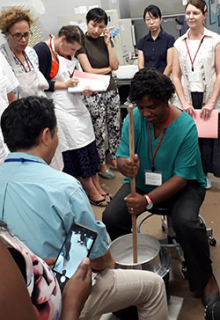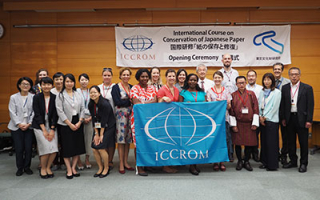The 2018 edition of the International Course on Japanese Paper Conservation (JPC) was held from 29 August to 17 September in Tokyo, Japan. This highly specialized, three-week event brought together ten heritage professionals from around the world. For the first time, colleagues from Fiji and Zambia joined the course.
The purpose of the course is to provide those caring for paper-based collections outside Japan with an insight into the materials and techniques of the Japanese paper-mounting tradition, and the principles guiding the care of such collections in Japan. Through improving their understanding of the basic characteristics of the Japanese paper tradition, participants should be in a better position to make decisions concerning the care of Japanese artifacts in their collections.
At the inauguration ceremony held on 27 August, the Deputy Director-General of TNRICP, Ms. Emiko Yamanashi, welcomed the course group. She emphasized this unique opportunity “to appreciate the quintessence of traditional Japanese culture and to become familiar with different kinds of Japanese paper, conservation materials, tools, and the environment in which conservation is carried out." Ms. Yamanashi also expressed her hope “that communities of the protectors of cultural heritage property will spread across different countries and regions through this international course.”
In the first week of the course, participants followed an intensive programme combining theory and practice. Experts from TNRICP shared lectures on paper conservation in Japan, paper basics, and adhesives used in the restoration of Japanese paintings, and also provided a tour of the TNRICP facilities. Following demonstrations by senior Japanese conservators, course participants had hands-on experience with conservation techniques including the preparation of starch paste, dry and wet cleaning, infilling, and lining.
During the second week, a study tour in the cities of Nagoya, Mino, and Kyoto gave participants the opportunity to see the living heritage of Japanese papermaking and paper restoration. Participants practiced traditional Japanese papermaking techniques, and had the option to purchase top quality Japanese paper and conservation materials and tools at local specialized shops. Besides traditional papermaking and restoration studios, the visits included: Nagoya Castle, Atsuta Jingu Shrine, Mino-Washi Museum, and the former Imai Residence and Mino Archives. Despite the powerful typhoon that hit Japan during those days, the course team took all necessary precautions to ensure the safety of the participants.
After the inspiring and informative study tour, participants deepened their practical skills for conservation of traditional Japanese scrolls during the third and last week of the course. Highlights of this week included an in-depth lecture on Japanese brushes, and fruitful discussions on the present conditions and transitions concerning the protection of craft techniques in Japan.
The course offered multiple opportunities to build bridges between the Japanese and the Western paper conservation traditions, and to help conservators assess the applicability of the Japanese approach, materials and techniques to non-Japanese cultural heritage.
The JPC course has been organized once a year since 1992, in collaboration between the Japanese heritage authorities in Tokyo and ICCROM. Over 200 international participants have benefited from this successful training partnership.
Member States represented: Argentina, Canada, Denmark, France, Japan, Poland, United Kingdom, United States of America, Venezuela, Zambia.
Non-Member States: Bhutan, Fiji.


